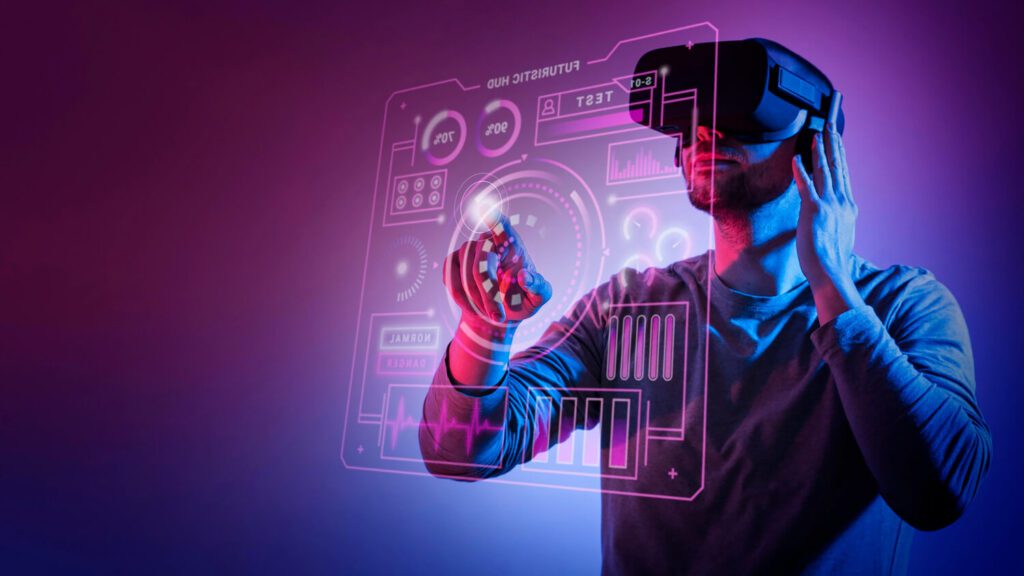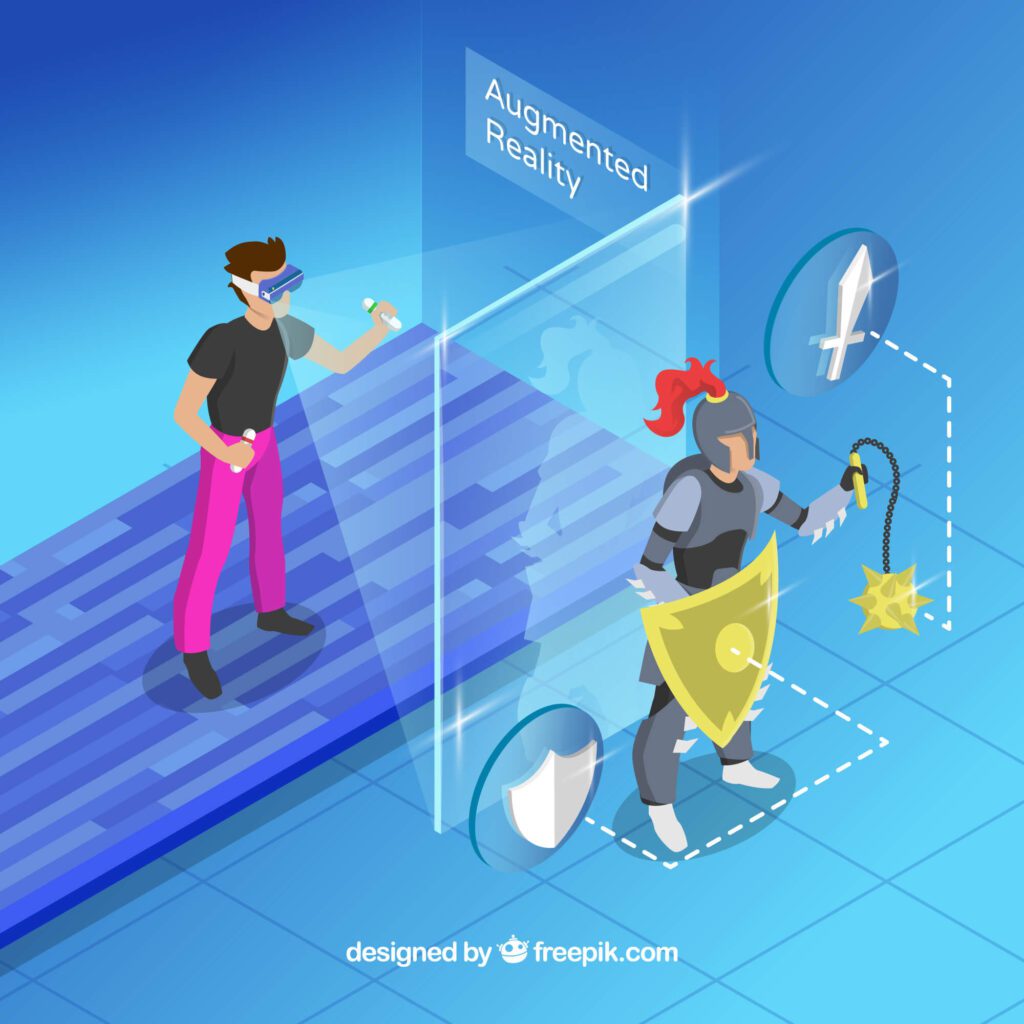Table of Contents
In an increasingly digital world, augmented reality (AR) and virtual reality (VR) have become important terms.
Although these technologies are often used interchangeably, they have distinct differences and similarities.
Augmented Reality (AR) and Virtual Reality (VR) are two important technologies in the increasingly digitalized world.
While these terms are often used interchangeably, it is crucial to understand their differences and similarities to leverage their full potential.

What is Virtual Reality (VR)?
In contrast, Virtual Reality (VR) is a computer-generated simulation that can create an alternative world or reality.
By incorporating appropriate hardware, users can fully immerse themselves in a digitally created environment.
VR headsets differ from AR headsets, as they require special sensory devices that translate real-world movements into the virtual realm.
The core concept of VR is to simulate a new reality, which users can perceive and interact with through VR screens and lenses.
The extensive hardware necessary for VR isolates users from the real world, offering a truly immersive experience.
How does Virtual Reality (VR) Work?
Display and Graphics:
One of the critical components of VR is the display system. Headsets such as the Oculus Rift or HTC Vive feature high-resolution screens that are positioned right in front of your eyes.
These displays utilize advanced optics to create a wide field of view, allowing you to perceive a 3D environment.
The graphics processing unit (GPU) plays a crucial role, rendering the virtual scenes in real-time and ensuring smooth and realistic visuals.
Head Tracking and Sensors:
To provide a sense of presence, virtual reality relies on accurate head tracking.
Accelerometers, gyroscopes, and magnetometers mounted within the headset track the user’s head movements and orientation.
This data is then processed in real time, allowing the virtual world to respond to your head movements.
With precise head tracking, you can look around and explore the virtual environment just as you would in the real world.
Audio and Sound:
Sound is another vital component that enhances the immersive experience of virtual reality. VR headsets are equipped with high-quality headphones or speakers to provide spatial audio.
The audio output changes based on the user’s head movement, creating a sense of depth and direction.
This helps in creating a truly immersive experience by allowing you to locate and engage with virtual objects based on sound cues.
Input Devices:
Interaction in virtual reality is made possible through various input devices. These can include handheld controllers, motion sensors, or even gloves. These devices allow users to manipulate objects, navigate through virtual worlds, and create a more immersive experience. Advanced haptic feedback systems also provide a sense of touch, further amplifying the feeling of realism.
Software and Content:
Behind the scenes, a robust software ecosystem powers the virtual reality experience.
Developers create immersive virtual environments and interactive content that can range from games and simulations to virtual tours and educational experiences.
These applications take advantage of the hardware capabilities to ensure a seamless and immersive experience for users.
The Pros and Cons of Virtual Reality (VR)
Every technology, including Virtual Reality (VR), comes with its own set of advantages and disadvantages.
Advantages of Virtual Reality (VR)
Immersive Learning Experience:
With VR, learners can engage in immersive learning experiences within interactive environments.
This deep level of engagement enhances understanding and retention of educational content.
Comprehensive Exploration:
VR allows users to explore the virtual world in its entirety. They can dive into various facets of the virtual environment, uncovering new perspectives and insights not possible in the real world.
Transforming Education:
The education sector greatly benefits from the possibilities offered by VR technology. It enables innovative teaching methods by providing students with engaging and interactive educational content.
Disadvantages of Virtual Reality (VR)
Limited Genuine Interaction:
Despite its immersive nature, VR lacks genuine interaction, especially in comparison to real-world experiences.
Physical touch and face-to-face communication cannot be fully replicated in virtual environments, limiting the authenticity of the interactions.
Temptation to Escape Reality:
An apparent drawback of VR is the temptation it poses to users to completely immerse themselves in the virtual world, sometimes neglecting their real-life responsibilities and relationships.
Incomplete Replacement of Real Training:
Although training or learning within VR environments offers numerous benefits, it cannot entirely replace real training experiences.
Physical training, hands-on practice, and real-life contexts provide unique learning opportunities that VR cannot fully replicate.
Practical uses of Virtual reality (VR):
Military Training:
The military utilizes VR technology in flight simulators and battlefield simulations.
By providing realistic and immersive training environments, VR enhances soldiers’ skills, decision-making abilities, and situational awareness.
Sports Training:
In the world of sports, VR offers digital training devices that aid athletes in improving their performance and analyzing their techniques.
Athletes can virtually practice and refine their skills, enhancing their training routines and overall performance.
Medical Treatment and Training:
VR has proven to be beneficial in the medical field in multiple ways.
Firstly, it can be used for treating post-traumatic stress disorder (PTSD) or anxiety disorders by exposing patients to virtual environments that assist in desensitization and therapeutic interventions.
Moreover, VR technology enables trainee doctors to practice and refine surgical techniques in a controlled virtual environment before performing them on real patients.
This enhances surgical proficiency, reduces errors, and promotes patient safety.

What is Augmented Reality (AR)?
Augmented Reality (AR) seamlessly combines the digital world with real-life elements.
This versatile technology can be used on both mobile devices and desktops, offering the unique ability to overlay digital components onto the physical world.
How does Augmented Reality (AR) Work?
It utilizes computer vision, depth tracking, and mapping to display various content in real-time.
By collecting data through cameras, AR can provide users with immediate access to digital information.
Special devices such as Smart Glasses enhance the full functionality of AR, delivering data through specialized software.
The Pros and Cons of Augmented Reality (AR)
Augmented Reality (AR) and Virtual Reality (VR) each have their own set of advantages and disadvantages, making it difficult to determine which technology is superior. Let’s explore the pros and cons specifically related to Augmented Reality:
Advantages of Augmented Reality (AR)
Individualized Learning:
AR enables personalized learning experiences, tailoring content to individual needs and preferences. This enhances the learning process by promoting engagement and retention.
Diverse Applications:
AR offers a wide range of applications across various industries, and these applications are continually evolving and improving.
From education to healthcare and retail, AR has the potential to transform numerous sectors.
Increased Accuracy and Efficiency:
AR technology fosters increased accuracy and efficiency in tasks that require precise information overlay, such as medical procedures or assembly instructions.
It provides real-time guidance, reducing errors and improving overall performance.
Remote Collaboration and Knowledge Sharing:
AR allows for the sharing of experiences and knowledge over long distances.
It enables remote collaboration, making it possible for experts to guide and assist others in real time, regardless of physical location.
Disadvantages of Augmented Reality (AR)
High Implementation Costs:
One significant drawback of AR is the comparatively high costs associated with implementing the technology.
The development of AR applications, hardware, and systems require substantial investments, limiting widespread adoption.
Performance Limitations:
Many existing AR devices have limitations in terms of performance, such as restricted field of view or device capabilities.
These limitations can impact the overall user experience and hinder widespread acceptance.
Privacy Concerns:
An important consideration with AR is the potential lack of user privacy. As AR relies on accessing personal data or capturing real-world surroundings, privacy concerns arise around data security, tracking, and the potential misuse of information.
Security Risks:
Neglecting to prioritize security measures when introducing augmented reality can lead to potential security breaches.
Augmented content may interact with critical systems, increasing the risk of unauthorized access or manipulation.
Practical Applications of Augmented Reality (AR)
Augmented Reality (AR) presents a wide range of possibilities, making it intriguing for both personal and business use. Here are some practical applications of AR in various fields:
Enhanced Print and Advertising Industry:
AR enables the overlay of digital content onto real magazines, enhancing the reader’s experience. This technology creates captivating and interactive advertising campaigns, revolutionizing the print industry.
Language Translation:
Modern translation apps leverage AR technology to enable users to translate texts into different languages.
By using the camera on their devices, users can instantly view translated content overlaid on the original text, facilitating communication across language barriers.
Construction and Logistics:
AR finds practical applications in the construction and logistics sectors, enhancing employee efficiency and streamlining business processes.
Overlaying digital information onto real-world objects improves workers’ ability to perform tasks precisely and efficiently, leading to increased productivity.
Enhanced Customer Interactions:
Augmented reality provides an easy and engaging way to connect with customers, colleagues, or technicians.
By utilizing AR, businesses can offer interactive product demonstrations, virtual showrooms, or remote assistance for technical troubleshooting, fostering better customer engagement and support.
The Mixed Reality:
There is the concept of mixed reality, which is a perfect mixture between AR and VR.
This technology is expected to become mainstream for consumers and businesses in the near future. It aims to enable instinctive interaction with data while eliminating the need for screen-based work.
Handheld devices can take on the tasks traditionally performed by stationary devices, making it easier to access centralized data anywhere and anytime.
The key difference lies in the level of immersion and interaction. VR offers unparalleled immersion, allowing users to explore and interact with a digital universe.
On the other hand, AR maintains a connection with reality by enhancing it with virtual elements.
Despite their differences, VR and AR share common goals of enhancing user experiences in various fields.
Whether it’s in gaming, education, healthcare, or architecture, both technologies offer promising opportunities for innovation.
It is crucial for businesses and individuals to understand the distinctions between these technologies to determine which one suits their needs best.
In conclusion, AR and VR are important technologies in the digital world. They have distinct differences and advantages, but their combination can create a more immersive and engaging experience for users.
Whether implementing AR, VR, or mixed reality, it is essential to consider the specific needs and applications to fully leverage these technologies in various sectors.
